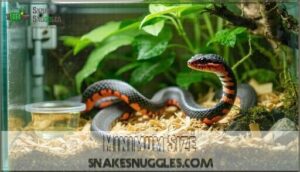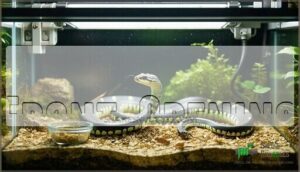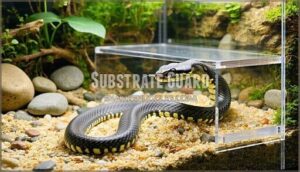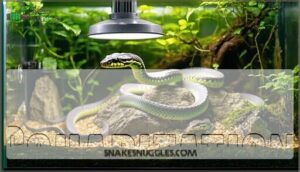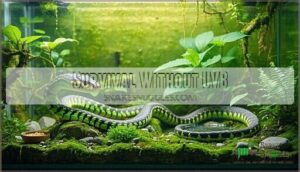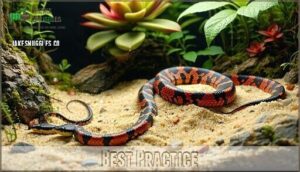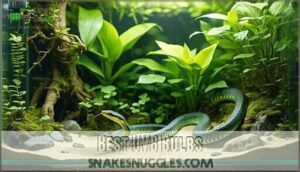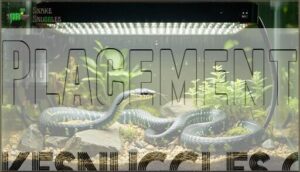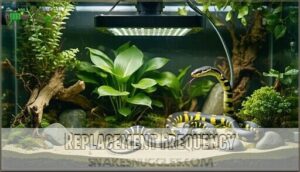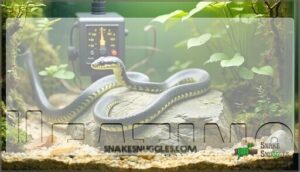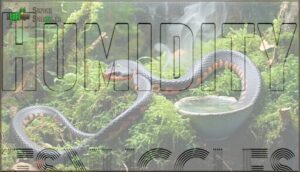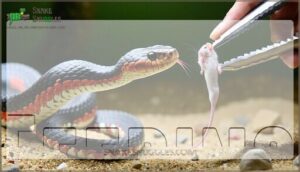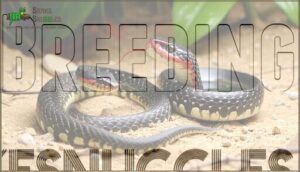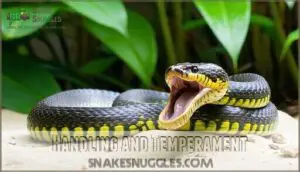This site is supported by our readers. We may earn a commission, at no cost to you, if you purchase through links.
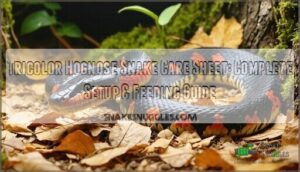
Deep substrate enables natural burrowing behavior, while frozen-thawed mice every 4-5 days feed neonates and every 7-10 days for adults. These dramatic little performers have fascinating defensive behaviors that make proper setup even more rewarding.
Table Of Contents
- Key Takeaways
- Enclosure Size
- UVB Lighting
- Heating
- Humidity
- Substrate
- Décor
- Feeding
- Breeding
- Handling and Temperament
- Frequently Asked Questions (FAQs)
- Are tricolor hognose snakes good pets?
- How much space does a tricolor hognose snake need?
- What temperature should a tricolor hognose snake be?
- Are tricolor hognose snakes ectotherms?
- Can tricolor hognose snakes survive without vitamins?
- What does a tricolor hognose snake look like?
- What is the average lifespan of a tricolor hognose snake?
- How often should I feed my tricolor hognose snake?
- Can tricolor hognose snakes be kept with other species?
- How can I tell if my tricolor hognose snake is healthy?
- Conclusion
Key Takeaways
- You’ll need a minimum 20-gallon long tank with front-opening doors, substrate guards, and deep substrate (3-4 inches) to support their natural burrowing behavior.
- Maintain proper temperature gradients with 90-95°F basking spots, 72-82°F cool zones, and 30-50% humidity levels using thermostat-controlled heating and UVB lighting for optimal health.
- Feed frozen-thawed mice appropriately—every 4-5 days for neonates, every 7-10 days for adults—and use scenting techniques if your snake refuses meals initially.
- Expect dramatic defensive behaviors like thrashing and body flattening when handling, but these subside with consistent, gentle interactions over time.
Enclosure Size
Getting the right enclosure size for your tricolor hognose snake sets the foundation for their health and happiness.
You’ll need to balance their natural burrowing instincts with practical space requirements that accommodate their adult size and behavioral needs.
Minimum Size
When considering space requirements for your tricolor hognose, think of their enclosure as their entire world. These compact serpents need adequate room to exhibit natural behaviors while feeling secure in their environment.
Minimum enclosure dimensions include:
- 20-gallon long tank for adult specimens measuring 18-24 inches in snake length
- 30" L x 12" W x 12" H as absolute minimum housing requirements
- Front-opening design with substrate guard preventing escape attempts
- Individual housing since cohabitation causes unnecessary stress reduction issues
Your enclosure size directly impacts your snake’s growth rate and overall well-being.
Remember, tricolor hognose care sheet guidelines emphasize meeting burrowing needs through proper housing and enclosure setup rather than cramped quarters.
Preferred Size
While the minimum works, a larger enclosure makes your tricolor hognose happier and healthier. Aim for 36"L x 18"W x 18"H to give your snake room to thrive. This extra space accommodates their natural behaviors and supports proper captive growth rates.
Your preferred enclosure should include:
- Deep substrate – 3-4 inches for natural burrowing behavior
- Multiple hiding spots – caves and cover throughout the space
- Temperature gradient – warm and cool zones for thermoregulation
- UVB placement area – half-length bulb positioning space
- Growth accommodation – room for adult size variations up to 24 inches
- Enrichment options – branches and décor for mental stimulation
Sexual dimorphism affects size variation, with females typically growing larger. Proper housing requirements support healthy growth rates and reduce stress-related health issues.
Front-Opening
Front-opening enclosures offer significant accessibility benefits for tricolor hognose care. You’ll find maintenance ease dramatically improved when cleaning and feeding your snake. These designs provide better viewing angles and superior escape prevention compared to top-opening alternatives.
Key Front-Opening Features:
- Magnetic latching systems – Provide reliable security features while allowing quick access
- Heavy-duty hinges – Guarantee long-term durability under regular use
- Sliding glass panels – Minimize disturbance during routine enclosure maintenance
- Multi-point locking mechanisms – Prevent accidental openings and unauthorized access
Choose enclosures with reinforced door frames and quality hardware. Many keepers also prefer to buy a complete enclosure kit. Your tricolor hognose will experience less stress during feeding and cleaning sessions.
Substrate Guard
With your front-opening enclosure ready, you’ll need a substrate guard to keep your tricolor hognose’s bedding where it belongs. Commercial guards offer professional-grade protection, while DIY guards using acrylic strips work just as well for budget-conscious keepers.
Installation tips include securing guards flush against the glass to prevent gaps where substrate can escape. When choosing guard materials, opt for smooth surfaces that won’t snag during cleaning. Regular cleaning of guards prevents buildup that could harbor bacteria.
A proper substrate guard transforms your enclosure into a contained ecosystem, making maintenance easier while keeping your snake’s burrowing paradise intact.
Substrate Depth Substrate Replacement
Substrate Types Substrate Cleanliness
Cohabitation
Cohere Risks make housing multiple tricolor hognose snakes together a risky proposition. These solitary animals naturally avoid each other in the wild, and forced proximity creates stress reduction challenges.
Dominance hierarchy conflicts emerge as snakes compete for prime basking spots and hiding areas. Resource competition leads to feeding disputes, potentially triggering aggressive behavior and dangerous thrashing behavior. Injury risk escalates when territorial disputes turn physical.
Ethical considerations weigh heavily—why stress your pets unnecessarily? Separate enclosures eliminate these hazards entirely, ensuring each snake thrives in its own space.
UVB Lighting
While tricolor hognose snakes can survive without UVB lighting, providing it substantially improves their health and natural behaviors.
UVB helps with calcium absorption, immune function, and overall vitality, making it an essential component of proper husbandry, as it markedly enhances their well-being.
Survival Without UVB
Your tricolor hognose snake’s survival doesn’t depend on UVB lighting, but proper husbandry includes it for ideal health. These diurnal reptiles benefit from UVB exposure, which supports vitamin D3 production, calcium absorption, and immune function.
Without UVB, you’ll face several challenges:
- D3 supplementation becomes essential through dietary needs
- Health impacts may include weakened bones and compromised immunity
- Long-term effects could shorten your snake’s lifespan
Alternative lighting options exist, but UVB remains the gold standard for tricolor hognose snake care.
Best Practice
UVB lighting’s benefits for tricolor hognose snake care go beyond basic survival—it’s essential for proper husbandry. While these fossorial snakes can technically live without UVB, responsible ownership means providing ideal conditions. Quality lighting supports calcium metabolism, immune function, and natural behaviors that enhance your snake’s wellbeing.
Here are three key advantages:
- Enhanced calcium absorption – UVB stimulates vitamin D3 synthesis, preventing metabolic bone disease
- Improved appetite and digestion – Natural light cycles regulate feeding responses and digestive processes
- Better immune system function – Proper lighting strengthens disease resistance and overall health
Use a 5% T8 or 2-5% T5 UVB tube with reflective fixtures for maximum efficiency.
Best UVB Bulbs
When selecting UVB bulbs for your tricolor hognose snake, three top performers stand out. The Arcadia ShadeDweller kit delivers targeted UVB spectrum perfect for fossorial species. The Arcadia T5 HO Forest 6% provides ideal UVB gradient across your enclosure. The Zoo Med T5 HO Reptisun 5.0 offers reliable UVB lighting with consistent output.
These fixture types guarantee proper vitamin D3 synthesis and immune support. Remember, bulb lifespan matters—replace every 12 months regardless of visible light. Quality brands address safety concerns while maintaining the UVB lighting requirements your snake needs for superior health.
These snakes benefit from UVB, which is essential for health.
Placement
Proper UVB placement maximizes your tricolor hognose’s health benefits while creating natural basking opportunities throughout the enclosure.
- Enclosure location: Position UVB tubes 6-12 inches above basking areas
- Lighting gradient: Create zones from high to low UVB exposure
- Heating integration: Align UVB with your primary heat source
- Substrate clearance: Maintain adequate depth for natural burrowing behavior
- Sunlight exposure: Avoid direct window placement that causes overheating
Replacement Frequency
Like clockwork, you’ll want to replace UVB bulbs every 12 months to maintain their effectiveness. Over time, these bulbs lose their UV output even while still producing visible light, making regular replacement essential for your snake’s vitamin D production and overall health.
Mark your calendar when installing new bulbs—your tricolor hognose depends on consistent UV exposure for proper calcium absorption and immune function.
Heating
Proper heating creates the temperature gradient your tricolor hognose needs to regulate its body temperature and digest food effectively. You’ll need to establish a warm basking area and a cooler retreat zone to mimic their natural thermal environment.
Basking Surface Temperature
When maintaining your tricolor hognose snake’s health, basking surface temperature becomes your most critical heating consideration. Set your basking lamp to create an optimal range of 90-95°F using thermostat control for precision.
Position the bulb distance appropriately above suitable surface material like naturalistic substrate.
Use temperature monitoring tools like infrared thermometers to verify your temperature gradient stays consistent, ensuring your snake can thermoregulate effectively between warm and cool zones.
Cool Side Temperature
Your tricolor hognose snake needs a cool side temperature between 72-82°F for proper thermoregulation. This temperature gradient allows your snake to move away from the basking area when needed. Monitor temperatures with digital thermometers and use thermostat control to maintain consistency. Night temperature drops to 70-75°F support natural cycles, though seasonal variation may cause minor fluctuations in your enclosure.
Here’s what proper cool side management means for your snake:
- Stress-free digestion – your snake can process meals comfortably without overheating
- Natural behavioral patterns – mimics wild temperature variations your snake instinctively expects
- Prevention of respiratory issues – consistent temperature monitoring prevents dangerous temperature swings
- Enhanced appetite and activity – proper gradients encourage natural feeding responses and exploration
Heat Lamp
For your tricolor hognose’s heating needs, you’ll want a halogen heat lamp positioned over one side of the enclosure. This creates the perfect temperature gradient your snake craves. Position the basking bulb above a flat stone on your substrate to create an ideal basking surface temperature. Wattage Selection depends on your tank size—start with 50-watt bulbs and adjust as needed. Thermostat Control prevents overheating disasters, while Lamp Safety means securing fixtures properly. Ceramic Heaters and Infrared Lamps work too, but halogen delivers that natural heating spectrum snakes love.
| Component | Recommended Option | Why It Matters |
|---|---|---|
| Bulb Type | 50W Halogen Flood | Natural light spectrum |
| Control | Dimming Thermostat | Precise temperature |
| Safety | Secure Fixture | Prevents burns/fires |
| Backup | Ceramic Heat Emitter | Nighttime warmth |
Heating Turn-Off
Establishing proper night temperatures creates a healthy circadian rhythm for your tricolor hognose snake. Turn off all heating methods at night, allowing temperatures to drop naturally to 70-75°F. Your thermostat settings should automate this process, preventing overheating risks while maintaining the essential temperature gradient.
During winter months, seasonal adjustment becomes necessary—your snake’s metabolism slows, requiring cooler conditions. Emergency power backups protect against dangerous temperature swings.
This lighting and heating cycle mimics their natural habitat, where basking surface temperatures fluctuate dramatically between day and night, promoting better digestion and overall health.
Heating Materials
Heating methods matter for your tricolor hognose’s health. Halogen heat bulbs provide the best infrared radiation, creating proper basking surface temperatures. Unlike rock heaters or unregulated heat mats, halogens mimic natural sunlight.
Ceramic heaters work as alternative options for nighttime warmth. You can find a variety of options online. Always use thermostats for heat mat safety and ideal temperature control.
Humidity
Humidity control is critical for your tricolor hognose snake’s health, as these South American natives require moderate levels around 50-60% to support proper shedding and respiratory function.
You’ll need to monitor humidity carefully since too much moisture can lead to scale rot, while too little causes difficult sheds and stress.
Average Humidity
Humidity levels between 30-50% keep your tricolor hognose snake healthy and comfortable. Poor humidity levels can lead to shedding issues and affect your snake’s respiratory health. You’ll need a digital probe hygrometer to track these levels accurately throughout the day.
Your snake’s hydration needs go beyond just drinking water. Proper humidity supports healthy skin and prevents stuck shed, which can cause serious problems if left untreated. When humidity drops too low, you’ll notice your snake struggling during shed cycles.
Monitoring methods should include checking your hygrometer twice daily. Place it at snake level, not near heat sources that might give false readings. A simple water dish helps maintain baseline humidity, but you’ll need additional methods during shedding periods. Watch for signs like dull skin or retained shed pieces – these indicate your humidity needs adjustment.
Humid Hide
Beyond maintaining average humidity levels, you’ll need to create a dedicated humid hide for shedding assistance. This specialized retreat helps your snake shed cleanly and reduces stress during vulnerable periods.
- Location importance: Position the humid hide on the warm side of the enclosure where your snake naturally gravitates for comfort
- Hide materials: Use plastic containers with entrance holes, commercial reptile caves, or repurposed tupperware for easy cleaning and mold prevention
- Substrate moisture: Line with dampened sphagnum moss or paper towels, maintaining consistent moisture without creating soggy conditions
- Humidity levels: Monitor with a digital probe hygrometer placed inside the hide to guarantee favorable microclimate conditions
Wet Substrate
Your snake’s wet substrate creates essential humidity measurement zones but requires careful management to prevent mold growth and bacterial infections. You’ll want to moisten only one section of your chosen substrate type, creating a gradient that supports natural shedding cycles while avoiding oversaturation.
Monitor substrate moisture levels closely—damp sphagnum moss in a hide box works perfectly for maintaining average humidity without risking scale rot. Coconut fiber advantages include safe humidity control.
Replace wet areas regularly to keep your tricolor hognose healthy and comfortable during vulnerable periods.
Humidity Measurement
Accurate monitoring keeps your tricolor hognose healthy and comfortable. Digital hygrometers offer precise readings, while analog hygrometers need regular humidity calibration for accuracy. Place your digital probe hygrometer on both warm and cool sides to check average humidity levels.
Follow these measuring techniques:
- Position humidity probes at snake level, not cage top
- Check readings twice daily during setup phase
- Maintain your humid hide at 80-90% moisture
- Calibrate devices monthly using salt test method
Proper humidity measurement prevents respiratory issues and guarantees successful sheds.
Substrate
As a fossorial species, tricolor hognose snakes need substrate that supports their natural burrowing behavior. You’ll want to provide at least 2-4 inches of appropriate material that allows them to tunnel and hide comfortably.
Essential for Fossorial Snakes
Your tricolor hognose snake’s burrowing behavior demands substrate that supports their fossorial nature. These digging specialists need substrate density that allows tunneling needs while maintaining enclosure security. Think of substrate as their construction material—too loose won’t hold tunnels, too compact prevents excavation. Naturalistic setups with proper substrate options create the foundation for healthy digging behavior, letting your snake express instincts through comfortable underground adventures.
Feature Importance
Depth
Your tricolor hognose snake needs adequate substrate depth to express natural burrowing behavior. Provide at least 2-4 inches of loose substrate, though deeper is better—especially for larger adults who appreciate more digging enrichment. Think of it like giving your snake its own underground playground. The depth gradient should accommodate complete burial, allowing your snake to disappear entirely when stressed or thermoregulating. Shallow substrate frustrates these fossorial reptiles and can lead to stress-related behaviors.
Avoid substrate compaction by choosing materials that maintain structure without becoming cement-like when slightly moist. Your snake will create natural burrow design patterns, often constructing multiple tunnels and chambers.
This depth also helps maintain the temperature gradient by providing cooler zones below the surface, complementing your lighting and heating setup while supporting natural thermoregulation behaviors that keep your snake healthy and content.
Substrate Options
Choosing suitable substrate options supports your tricolor hognose’s natural digging behavior while preventing substrate toxicity. Consider these five proven choices:
- Aspen shavings – Excellent for burrowing depth, low dust, affordable cost analysis
- Zoo Med Eco Earth – Superior moisture retention, made from coconut coir
- Cypress mulch – Natural mold resistance, maintains humidity gradients
- Organic topsoil blends – Mimics native habitat, must be pesticide-free
- Paper towels – Safe for quarantine, easy waste monitoring
Avoid pine/cedar shavings due to toxic oils. Proper substrate depth allows natural burrowing behaviors and exploration. Mix substrates for ideal substrate moisture balance – dry areas near heating, damp zones near water bowls.
Décor
Your tricolor hognose needs strategic décor placement to create proper temperature zones and security. Well-positioned hiding spots and a moist hide box will help your snake feel safe while supporting natural behaviors like thermoregulation and shedding.
Hiding Places
Your snake deserves multiple secure hideouts to feel at home. Proper hide placement creates confidence and reduces stress throughout their environment.
1. Secure Hiding: Provide at least two hiding places – one on the warm side and one on the cool side of the enclosure to maintain proper temperature choices.
2. Multiple Hides: Add various hide materials like cork bark, commercial caves, or upside-down plant pots with entrance holes to offer different textures and security levels.
3. Hide Materials: Choose materials that won’t retain moisture or develop harmful bacteria – smooth surfaces work best for regular cleaning and maintenance.
4. Cleaning Hides: Remove and sanitize hiding places monthly using reptile-safe disinfectant, ensuring your snake’s health and preventing odor buildup in the enclosure décor.
Moist Hide Box
A proper moist hide box becomes your tricolor hognose’s personal spa retreat during stressful shedding periods. This essential hide materials setup requires careful attention to humidity levels and substrate moisture management.
Here’s your step-by-step approach:
- Choose sphagnum moss or coconut fiber for ideal moisture retention
- Size appropriately – your snake should fit comfortably inside
- Monitor humidity levels with a digital hygrometer regularly
- Replace substrate every 3-5 days to prevent mold prevention issues
- Position strategically for proper location placement accessibility
Your humid hide should maintain consistent moisture without becoming waterlogged. This proper husbandry practice supports healthy snake shedding cycles while preventing bacterial growth.
Temperature Gradient
Your tricolor hognose snake needs a proper temperature gradient to thermoregulate effectively. Position your heating sources to create distinct zones across the enclosure.
Zone Temperature Effect
Use thermostat control and monitoring tools to maintain this ideal range. Gradient importance can’t be overstated—your snake will shuttle between zones based on its needs.
Feeding
Feeding your tricolor hognose snake correctly guarantees healthy growth and prevents common problems like refusal to eat.
You’ll need to adjust prey size and feeding frequency as your snake matures from neonate to adult.
Neonate Diet
Feeding neonate tricolor hognoses requires careful attention to their specific dietary needs. These tiny snakes won’t eat just anything you offer, so understanding their requirements helps guarantee healthy growth.
Here’s how to properly nourish your baby tricolor hognose:
- Pinky Size Selection: Choose frozen-thawed pinkie mice that match your snake’s thickest body section. The meal shouldn’t create a noticeable bulge after feeding—think snug fit, not stuffed sausage.
- Feeding Schedule Consistency: Feed neonates every 4-5 days consistently. This frequency supports their rapid metabolism without overwhelming their digestive system.
- Scenting Techniques: Many neonate tricolor hognoses won’t recognize pinky mice as food initially. Rub the prey with lizard or toad scent to trigger their natural feeding response—this simple trick often solves feeding refusal causes.
- Vitamin Supplementation: Dust prey lightly with Repashy Calcium Plus LoD before offering. This guarantees proper bone development during their critical growth phase.
Remember, feeding refusal happens occasionally—don’t panic if your snake skips a meal.
Young Snake Diet
As your tricolor hognose snake matures past the neonate stage, you’ll need to adjust pinky size accordingly. Young snakes typically graduate from frozen/thawed pinkie mice to fuzzies, then small adult mice.
Maintain your feeding schedule of every 4-5 days during this growth phase. Consider scenting options like lizard or toad scent to encourage feeding.
Dietary variety remains important, though supplementation needs are minimal with proper prey rotation.
Scenting Mice
Sometimes your snake might turn its nose up at plain mice, but scenting can work wonders. This Tricolor hognose snake feeding technique mimics their natural scents from wild prey. Here’s how to master scenting mice for better prey acceptance.
- Use amphibian scents: Rub mice with frog or toad skin—these scenting methods trigger strong feeding responses in reluctant eaters.
- Try commercial options: Scenting alternatives like Reptilinks Frog Scent offer consistent results without wild-caught risks.
- Gradually reduce dependency: After successful scented feeding frequency, slowly switch to unscented mice to prevent long-term imprinting issues.
Adult Feeding Frequency
Feed your adult tricolor hognose snake every 7-10 days with appropriately sized frozen-thawed pinkie mice or adult mice, depending on prey size needs. This feeding schedule mirrors their natural hunting patterns while preventing obesity.
Monitor your snake’s weight regularly, as seasonal changes can affect appetite. Don’t panic if your snake refuses meals occasionally – refusal reasons include shedding cycles, breeding season, or temperature fluctuations.
Consistent weight monitoring helps you adjust portions and timing for ideal tricolor hognose snake health and maintains proper adult feeding frequency.
Breeding
Breeding tricolor hognose snakes requires careful preparation and favorable conditions to guarantee successful reproduction. You’ll need to monitor female weight, provide proper nutrition, and understand the breeding cycle to achieve healthy clutches.
Female Weight for Breeding
Before breeding your tricolor hognose snake, verify your female weighs at least 200 grams—this optimal weight signals she’s reached proper breeding age and can handle egg production.
A well-conditioned female at this weight will produce healthier clutches and recover better afterward. Weight cycling through proper feeding prepares her body for the demanding breeding process ahead.
Additional Meals
Once your female reaches breeding weight, you’ll need to boost her nutrition substantially. Additional meals help her body handle the energy demands of egg production and maintain her health throughout the process.
Here’s what you should focus on:
- Increase feeding frequency – Feed every 4-5 days instead of weekly during pre-breeding conditioning
- Offer larger prey items – Adult mice provide more calories than frozen/thawed pinkie mice for energy storage
- Add dietary supplements – Calcium and vitamin supplements support shell development and prevent deficiencies
- Monitor for obesity risks – Watch her weight carefully since overfeeding can cause complications during egg-laying
This enhanced tricolor hognose snake diet prepares her body for the upcoming reproductive cycle.
Clutches Per Year
Your tricolor hognose snake can produce multiple clutches of eggs per year, with healthy females laying four to five clutches annually. Each clutch typically contains 4-8 eggs, making these snakes quite prolific breeders.
Clutch frequency depends on your female’s reproductive health and body condition. Breeding season timing affects egg production, with proper nutrition supporting consistent clutch size.
Monitor your snake’s weight and behavior between clutches, as egg viability improves when females recover fully between breeding cycles.
Incubation Times
Perfect Temperature Stability at 28-30°C produces reliable Incubation Duration of 55-65 days for your tricolor hognose snake eggs. Lower temperatures extend incubation times to 75 days, while excessive heat above 32°C kills embryos. Hatchling Rates drop dramatically with temperature swings or poor humidity control. Most breeding programs report 60 days as the average hatching time.
You’ll need Humidity Levels between 80-90% using vermiculite or perlite as Incubation Mediums. Egg production success depends on maintaining these precise conditions throughout the entire incubation period.
Check eggs weekly for development signs, marking tops to prevent lethal rolling. Environmental control is essential for success.
Handling and Temperament
Tricolor hognose snakes have quite the dramatic personality when first handled, often putting on an impressive defensive display.
With consistent, gentle handling sessions, most snakes will calm down and become more manageable pets.
Thrashing Behavior
Your tricolor hognose snake might throw what looks like a reptilian tantrum when you first handle it. Defensive thrashing serves as the snake’s primary alarm system—wild flailing that screams "leave me alone!" This handling behavior stems from fear rather than aggression.
Your snake’s dramatic flailing is just fear, not fury—patience transforms tantrums into trust
Causes of thrashing include stress, unfamiliarity with human contact, and natural defensive behavior patterns. Understanding their defensive postures can help you recognize when they feel threatened.
Reducing thrashing requires patience and consistent, gentle interactions. Start with brief sessions, letting your snake adjust gradually. Thrashing intensity typically decreases as trust builds. The thrashing purpose is simple survival instinct, but regular handling transforms nervous energy into calm acceptance over time.
Flattening Forepart
When your snake feels cornered, it’ll dramatically flatten the forepart of its body like a cobra wannabe. This defensive behavior makes their triangular head appear larger and shows off their coral mimicry patterns.
Unlike thrashing behavior, this flattening forepart happens when they’re trying to look intimidating rather than escape. It’s their way of saying "back off" without actually meaning it.
Most handling sessions calm them down quickly once they realize you’re not a threat.
Size and Shape
Understanding your tricolor hognose snake’s physical description starts with knowing what to expect size-wise. Adult length typically ranges from 18-24 inches, with sexual dimorphism evident—females generally reach the full 24 inches while males stay closer to 18-20 inches. You’re not dealing with giants here; are tricolor hognoses big snakes? Not really—they’re compact and manageable.
Body proportions showcase a cylindrical build with smooth scales, creating that classic hognose silhouette. The distinctive snout shape—upturned and slightly pointed—gives these snakes their signature look and helps with their natural digging behavior. This upturned nose isn’t just for show; it’s perfectly designed for burrowing.
Scale count contributes to their smooth appearance, while their striking red, black, and white banded pattern makes identification straightforward. At maturity, expect around 271 grams of solid snake. Their average lifespan of 7-8 years means you’ll have plenty of time to appreciate their unique proportions. Consider appropriate enclosure size based on these dimensions—their compact build makes housing relatively straightforward compared to larger species.
Bite and Venom
Mildly venomous tricolor hognose snakes rarely bite defensively, preferring dramatic bluffing displays instead. Their rearfanged venomous delivery system requires prolonged chewing for effective envenomation.
Bite symptoms typically include minor swelling and redness, similar to bee stings. Venom potency remains low with no documented fatalities. Allergic reactions can occur, so monitor bites closely.
Medical treatment usually involves basic first aid and observation for complications. These snakes are known for their docile temperaments, making them easy to handle.
Handling Subsides
With time and patient handling, your tricolor hognose’s thrashing behavior will fade. Start with brief, gentle handling sessions every few days to build trust. Watch for stress signs like excessive hissing or hiding.
These taming techniques reduce bite risk while establishing safe handling routines. Consistent handling frequency transforms defensive snakes into calmer companions through positive reinforcement.
Frequently Asked Questions (FAQs)
Are tricolor hognose snakes good pets?
Yes, tricolor hognose snakes can make good pets with proper care. They’re mildly venomous but generally docile.
You’ll need appropriate housing, heating, UVB lighting, and regular feeding schedules to keep them healthy.
How much space does a tricolor hognose snake need?
You’ll need a minimum 36"L x 18"W x 18"H enclosure for adult tricolor hognose snakes.
A 20-gallon long tank works perfectly, providing enough room for burrowing and exploration without overwhelming your snake.
What temperature should a tricolor hognose snake be?
Your tricolor hognose needs a temperature gradient: 88-90°F basking spot, 75-85°F ambient range, dropping to 70-75°F at night.
Use a halogen bulb with dimming thermostat for proper heat control.
Are tricolor hognose snakes ectotherms?
Like tiny solar panels soaking up warmth, you’ll find that tricolor hognose snakes are indeed ectotherms. They can’t generate their own body heat, so they’ll rely on external sources like your heating setup to regulate their temperature and maintain proper metabolism.
Can tricolor hognose snakes survive without vitamins?
Adequate nutrition can’t be skipped—your snake needs calcium and vitamin supplementation to prevent deficiencies. Without proper nutrients, they’ll develop serious health issues including metabolic bone disease and weakened immunity.
What does a tricolor hognose snake look like?
You’ll recognize a tricolor hognose by its cylindrical body with vivid red coloring interrupted by broad black bands that enclose white stripes, creating distinctive rings reminiscent of coral snakes.
What is the average lifespan of a tricolor hognose snake?
Picture your scaly companion gracefully exploring its terrarium for years to come. You’ll enjoy your tricolor hognose snake‘s company for approximately 7-8 years in captivity with proper care and attention.
How often should I feed my tricolor hognose snake?
Feed juveniles every 5-7 days and adults every 7-10 days. You’ll use appropriately sized frozen/thawed mice – pinkies for babies, fuzzies or small adults for grown snakes.
Don’t worry if they occasionally refuse meals during shedding or winter.
Can tricolor hognose snakes be kept with other species?
While they share habitats in the wild, you shouldn’t house tricolor hognose snakes with other species. Cohabitation creates stress, territorial disputes, and disease transmission risks that compromise their health and wellbeing substantially.
How can I tell if my tricolor hognose snake is healthy?
Look for bright, alert eyes and a supple body that responds well to gentle handling.
Your snake should eat regularly, shed cleanly, and stay active without signs of lethargy, discharge, or breathing issues.
Conclusion
Surprisingly, tricolor hognose snakes can live up to 18 years in captivity when their specific care requirements are met properly. This detailed tricolor hognose snake care sheet covers everything you’ll need to create an ideal environment for these dramatic little performers.
From proper enclosure setup with deep substrate for burrowing to maintaining correct temperature gradients and humidity levels, each element plays a vital role in your snake’s health and happiness. With consistent care and proper feeding schedules, you’ll enjoy years of fascinating behavior from these charming reptiles.

